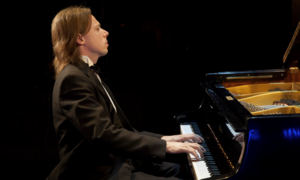When Steven Hageman, Executive Director of the Asheville Symphony, greeted the nearly full house in Thomas Wolfe Auditorium with the remark that the Symphony appeared to be the hottest ticket in town, he was merely corroborating what is now accepted as a fact of Asheville’s cultural life. Through the inspired leadership of Music Director and Conductor Daniel Meyer, the orchestra has won a loyal following, and with good reason. Their performances are consistently first-rate, with programming that ranges from the tried-and-true to works of a more experimental nature, all changed up with a variety of guest artists who already hold the attention of the world. Van Cliburn Silver Medalist Joyce Yang was the piano soloist in Rachmaninoff’s Rhapsody on a Theme of Paganini. Two B’s — Bizet’s L’Arlésienne Suite No. 1 and Beethoven’s Symphony No. 4 in B-flat, Op. 60 — rounded out the program. The concert was sponsored by Mr. and Mrs. Henry W. Kramer. The concert was recorded for re-broadcast by WCQS-FM on Thursday, February 7, 2013 at 8:00 PM
Ms. Yang is one of the most impressive pianists I have had the privilege to hear. Technically rock-solid and musically sophisticated, she is an artist whose mature interpretations belie her age. Actually, she’s been at this business a long time, having built an impressive performance resume as a child in her native Korea. Her career in the US where she is active as a soloist and chamber musician has soared to international prominence. She is featured in the documentary In the Heart of Music, a film about the 2005 Van Cliburn International Piano Competition.
The program opener was the Bizet L’Arlésienne Suite No. 1. Composed in1872 for a play by Alphonse Daudet called L’arlesienne, this incidental music in four movements conjures up the folk dances of Provence. As such it is not a profound piece, but deeply charming and evocative. The care with which the orchestra performed this work, with its carefully calibrated voicings, timbres and shadings, reflects the artistic “ethos” of a first-class ensemble — i.e., attention to detail matters, even in the simplest pieces. So, what could have been but a prelude to the larger works to come became significant in its own right and worth a close listen.
I have heard the Rachmaninoff Rhapsody on a Theme of Paganini live many times, but never with the degree of inspired playing and profound interpretation as I experienced here. Yang and Meyer are so secure in what they do that there was latitude for playfulness and a sense of savoring each moment as it came. The famous Variation 18, usually an outpouring of over-the-top sentimentality, was calibrated into moments of quiet and intimate delicacy before blossoming into a more extroverted sentiment (but still not overplayed). Each variation had its character and its moment, and while the soloist’s virtuosity was never in question, it was the consummate musicality of each force that brought me close to tears. After three curtain calls, Yang performed as an encore “My Joys” from Polish Songs, Op. 74; a Chopin song transcribed by Liszt which she had heard on a recording by Rachmaninoff.
The Beethoven was the program closer. Sandwiched as it is between the more famous “Eroica” and 5th Symphonies, it is a work that is largely underappreciated, and certainly less performed. Though plagued with an ongoing personal crisis during the years of the symphony’s composition, what humor Beethoven preserved within its pages! The first movement opens with a lengthy slow introduction, as Beethoven must have been toying with audience expectations. The orchestra segued naturally into the exuberant Allegro Vivace which proceeded at a very fast clip. The Adagio was not a typical, lyrical movement, but was underscored with a muscularity lacking in Haydn, its rising two-note motive sounding at times like an insistent sledgehammer. The third movement Scherzo was a delightful romp, with jolting metric dislocations, motives which rippled easily through the ensemble and a trio with a more transparent orchestration. The final movement was the funniest of all — Beethoven’s major theme is a fiddling exercise which has the strings working overtime on a figure that sounds idiomatic to them, but then appears in other sections (toward the end, in a fiendishly exposed bassoon part), which must have given the players of his day reason to question his sanity and maybe curse the part before them. This orchestra really pulled it off, bringing this exceptional program to a rousing close.











